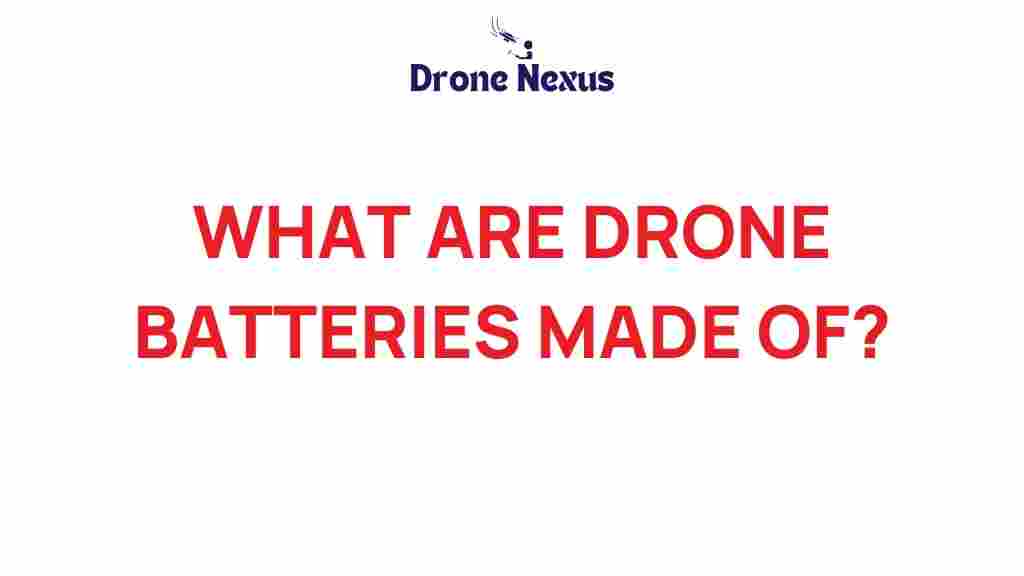Unveiling the Secrets: What Are Drone Batteries Made Of?
As the world of technology continues to evolve, drones have emerged as one of the most exciting innovations. Whether for recreational use, aerial photography, or commercial applications, these flying machines rely heavily on a critical component: drone batteries. Understanding what these batteries are made of can enhance your knowledge of drone performance, longevity, and efficiency. In this article, we will delve into the composition of drone batteries, how they work, and essential tips for maintenance.
Understanding Drone Batteries
Drone batteries are rechargeable power sources that provide the necessary energy for a drone to operate. The most common types of batteries used in drones are Lithium Polymer (LiPo), Lithium-ion (Li-ion), and Nickel-Metal Hydride (NiMH). Each type has its unique characteristics, affecting performance and usability.
Types of Drone Batteries
- Lithium Polymer (LiPo): These are the most popular batteries used in drones due to their high energy density and lightweight nature. LiPo batteries can deliver high discharge rates, making them ideal for racing drones and high-performance models.
- Lithium-ion (Li-ion): While slightly heavier than LiPo batteries, Li-ion batteries have a longer lifespan and better thermal stability. They are commonly used in consumer drones.
- Nickel-Metal Hydride (NiMH): This type of battery is less common but is used in some beginner drones. NiMH batteries are more robust and safer but generally provide lower energy density compared to LiPo and Li-ion batteries.
Composition of Drone Batteries
Now that we understand the types of drone batteries, let’s explore their composition:
Lithium Polymer Batteries
LiPo batteries are composed of several key elements:
- Electrolyte: A polymer electrolyte is used, which allows for a lightweight design.
- Anode: Typically made of carbon (graphite), the anode stores lithium ions during the charging process.
- Cathode: Composed of lithium metal oxide, the cathode releases lithium ions during discharge.
Lithium-ion Batteries
Li-ion batteries consist of the following components:
- Electrolyte: A liquid or gel electrolyte, usually lithium salt dissolved in organic solvent.
- Anode: Often made from a graphite material.
- Cathode: Typically contains lithium metal oxide compounds.
Nickel-Metal Hydride Batteries
NiMH batteries include:
- Electrolyte: An alkaline electrolyte, usually potassium hydroxide.
- Anode: Made from a hydrogen-absorbing alloy.
- Cathode: Composed of nickel oxide hydroxide.
How Drone Batteries Work
Understanding how drone batteries operate is crucial for maximizing their performance. Here’s a simplified overview of the functioning:
- Charging: When a drone battery is connected to a charger, lithium ions move from the cathode to the anode through the electrolyte, storing energy.
- Discharging: When the drone is powered on, lithium ions flow back to the cathode, generating electric current that powers the drone’s motors and electronics.
- Cycle: Each charge and discharge is known as a cycle. Batteries have a limited number of cycles, after which their capacity diminishes.
Choosing the Right Drone Battery
Selecting the right drone battery is essential for optimizing your drone’s performance. Here are some factors to consider:
- Capacity: Measured in milliamp hours (mAh), a higher capacity means longer flight times.
- Voltage: Ensure compatibility with your drone’s specifications. Common voltages include 3.7V (1 cell), 7.4V (2 cells), and 11.1V (3 cells).
- Discharge Rate: Measured in C-rating, a higher discharge rate is necessary for high-performance drones.
Maintaining Your Drone Batteries
Proper maintenance of your drone batteries can significantly extend their lifespan. Here are some maintenance tips:
- Storage: Store batteries in a cool, dry place. Avoid extreme temperatures and direct sunlight.
- Charge Cycle: Avoid fully discharging your LiPo batteries. Keep them within a safe voltage range to prolong their lifespan.
- Use a Balance Charger: When charging LiPo batteries, use a balance charger to ensure all cells are charged evenly.
Troubleshooting Common Battery Issues
Even with proper maintenance, you may encounter issues with your drone batteries. Here are some common problems and their solutions:
- Battery Not Charging: Check your charger and ensure it’s compatible with your battery type. Inspect the battery terminals for signs of damage.
- Short Flight Time: If your drone isn’t flying as long as it used to, it may be time to replace the battery. Check for swelling or other damage.
- Overheating: If the battery gets excessively hot during use or charging, disconnect it immediately and allow it to cool down.
Conclusion
Understanding what drone batteries are made of and how they work can significantly influence your drone experience. From selecting the appropriate battery type to maintaining and troubleshooting, the insights shared in this article are designed to help you maximize your drone’s performance. For more information about drone technology, check out our comprehensive guide on drone maintenance. Additionally, for in-depth insights into battery technology, visit Battery University. Remember, a well-maintained battery is the key to a successful flight!
This article is in the category Technology and created by DroneNexus Team

3 thoughts on “Unveiling the Secrets: What Are Drone Batteries Made Of?”